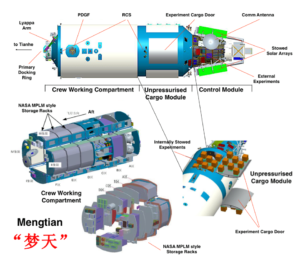
According to U.S. Space Command, an out-of-control rocket from China re-entered the Earth’s atmosphere over an unpopulated area of Texas. It isn’t clear if debris reached the surface, but the incident has troubled U.S. authorities who have said these dangerous rockets pose a threat to people in population centers. This is the fifth out-of-control rocket China has had since May 2020.
“This was an uncontrolled entry, meaning it was not steered, rather its orbit decayed and lowered naturally,” U.S. Space Command said. “This type of behavior reinforces the need for better international norms regarding high-risk controlled reentries.”
During the past out-of-control rocket episode from China, NASA Administrator Bill Nelson issued a statement condemning China’s approach of disposing spent rockets.
“Once again, the People’s Republic of China is taking unnecessary risks with the uncontrolled rocket stage reentry of their Long March 5B rocket stage. They did not share specific trajectory information which is needed to predict landing zones and reduce risk. This is the PRC’s fourth uncontrolled reentry since May 2020, and each of these reentries have been the largest in the last 30 years,” Nelson’s statement read.
“It is critical that all spacefaring nations are responsible and transparent in their space activities and follow established best practices, especially, for the uncontrolled reentry of a large rocket body debris –debris that could very well result in major damage or loss of life.”
U.S. Space Command, the 11th Combatant Command in the Department of Defense, confirmed that the People’s Republic of China CZ-2D Rocket Body, a March Long 5B style of rocket, reentered the Earth’s atmosphere over Texas at about 8:30 pm local time on March 8. The rocket, a second stage booster, lifted off into space from China on June 23, 2022.
With uncontrolled re-entries like this one, there is always a risk people on the ground could be hurt or killed by the debris.
“The general rule of thumb is that 20–40% of the mass of a large object will reach the ground, but the exact number depends on the design of the object,” wrote Marlon Sorgem a technical fellow for the Space Innovation Directorate of the Aerospace Corporation in a recent online question and answer session specific to an out-of-control Chinese rocket. “In this case, we would expect about five to nine metric tons. Generally, for an upper stage, we see small and medium tanks survive more or less intact, and large engine components. The large tanks and the skin of this core stage are likely to come apart. We will also see lightweight items such as insulation fall out. The melting point of the materials used will make a difference in what remains.”
Despite international condemnation of China’s last out-of-control rocket which struck Earth in May of last year, which followed another similar impact in May of 2020, China has not employed any new technology or safety mechanisms to steer the rocket back to Earth safely, as SpaceX rockets do, or deposit rockets in the South Pacific ocean far from any land mass or ocean shipping routes, as what most rocket launchers around the world do when sending satellites into space.

Other countries have had troubles with rockets too. In January of last year, a rocket from Russia crashed after an uncontrolled re-entry into the Earth’s atmosphere. Even the U.S. and NASA has problems every now and then too; according to the Center for Orbital and Reentry Debris Studies, a woman walking through a park in Tulsa, Oklahoma was apparently hit by debris from a NASA rocket. While she was walking outside through a park, she saw a fireball in the sky above and felt something strike her shoulder. Fortunately, the palm-sized chunk of metal didn’t injure her, but analysis showed the debris was a part of a fuel tank from a Delta II rocket that NASA had used to launch a satellite into space.
On Halloween, October 31, China launched their massive Long March 5B rocket to deliver the third and final experiment module to China’s Tiangong Space Station. Known as the Mengtian module, it was lifted into space successfully by an estimated 22.5 metric ton core booster. Unable to participate in the International Space Station (ISS) due to restrictions imposed by the United States, China has embarked on building their own called “Tiangong.” With the ISS due to be retired in the coming years, Tiangong may remain as the only working space station in Earth’s orbit.

The Long March 5, developed by the China Academy of Launch Vehicle Technology, roughly matches the capabilities of American rockets like the ULA Delta IV Heavy and the SpaceX Falcon Heavy. The massive rocket that was used to bring the GOES-R and GOES-S weather satellites to orbit was a ULA Atlas V; despite its size, it’s considerably smaller and less powerful than the Long March 5. The Long March 5 core stage has roughly 7x the mass of the Space X Falcon 9 second stage. The Long March 5b launches from a spaceport on Hainan Island in southeastern China.
The Wenchang facility on Hainan Island allows launch vehicles to soar over the South China Sea; previous launches lifted-off from inland launch facilities, forcing used rocket stages to fall onto land. Previous rocket stages have crashed into people’s homes in China. In the United States, such launches lift-off from launchpads near water, allowing spent rocket stages to tumble back to the ocean. Prior to such an event, NASA in partnership with local government agencies, put the projected splash-down area as a “no-fly” / “no-boat” area until the debris is safely down.
However, as was the case when China launched space station components in 2020 and 2021, the spent Long March 5 main stage tumbled back to Earth in an uncontrolled manner earlier this month. Of the uncontrolled reentries of Long March rockets in 2020, 2021, and 2022, two resulted in large debris landing near populated areas. According to Aerospace Corporation, over 88% of the world’s population lives under today’s rocket’s potential debris footprint.